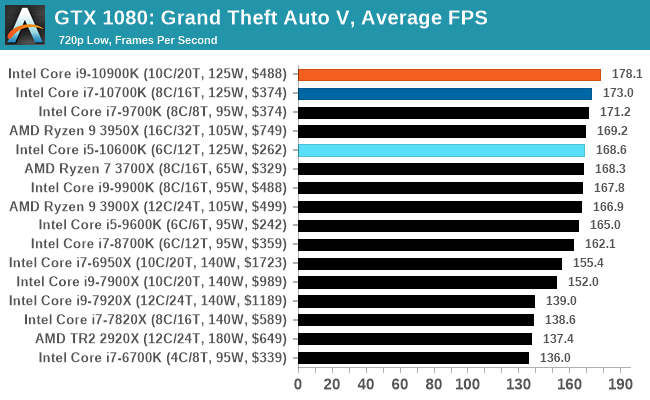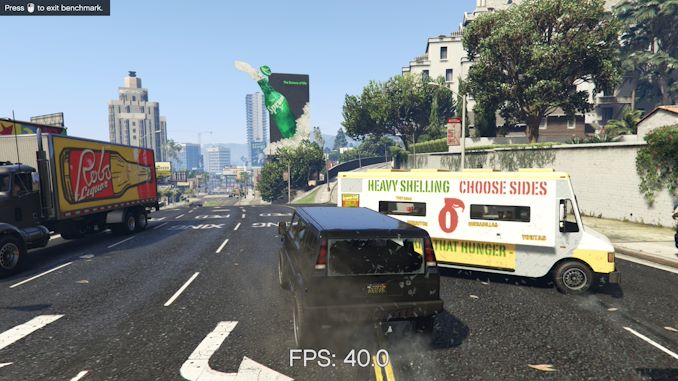The Intel Comet Lake Core i9-10900K, i7-10700K, i5-10600K CPU Review: Skylake We Go Again
by Dr. Ian Cutress on May 20, 2020 9:00 AM EST- Posted in
- CPUs
- Intel
- Skylake
- 14nm
- Z490
- 10th Gen Core
- Comet Lake
Gaming: Grand Theft Auto V
The highly anticipated iteration of the Grand Theft Auto franchise hit the shelves on April 14th 2015, with both AMD and NVIDIA in tow to help optimize the title. GTA doesn’t provide graphical presets, but opens up the options to users and extends the boundaries by pushing even the hardest systems to the limit using Rockstar’s Advanced Game Engine under DirectX 11. Whether the user is flying high in the mountains with long draw distances or dealing with assorted trash in the city, when cranked up to maximum it creates stunning visuals but hard work for both the CPU and the GPU.
For our test we have scripted a version of the in-game benchmark. The in-game benchmark consists of five scenarios: four short panning shots with varying lighting and weather effects, and a fifth action sequence that lasts around 90 seconds. We use only the final part of the benchmark, which combines a flight scene in a jet followed by an inner city drive-by through several intersections followed by ramming a tanker that explodes, causing other cars to explode as well. This is a mix of distance rendering followed by a detailed near-rendering action sequence, and the title thankfully spits out frame time data.
There are no presets for the graphics options on GTA, allowing the user to adjust options such as population density and distance scaling on sliders, but others such as texture/shadow/shader/water quality from Low to Very High. Other options include MSAA, soft shadows, post effects, shadow resolution and extended draw distance options. There is a handy option at the top which shows how much video memory the options are expected to consume, with obvious repercussions if a user requests more video memory than is present on the card (although there’s no obvious indication if you have a low end GPU with lots of GPU memory, like an R7 240 4GB).
All of our benchmark results can also be found in our benchmark engine, Bench.

| AnandTech | IGP | Low |
| Average FPS |  |
 |
| 95th Percentile |  |
 |











220 Comments
View All Comments
schujj07 - Wednesday, May 20, 2020 - link
That doesn't make any sense. The Crysis CPU render is new as of the Ryzen 3300X review from 2 WEEKS ago. https://www.anandtech.com/show/15774/the-amd-ryzen...catavalon21 - Wednesday, May 20, 2020 - link
AMD is shown leading in many CPU tests dollar for dollar or watt for watt.Achaios - Wednesday, May 20, 2020 - link
Chipzilla, due to its greed, got us back to the Heat Output of 2008 processors such as the Yorkfield QX 9650.Lookup "Overclocking Intel's New 45nm QX9650: The Rules Have Changed" by Anandtech, and check the thermal output of the QX 9650.
I don't see why any enthusiast would buy these overpriced and bad cpus. I certainly won't.
t.s - Wednesday, May 20, 2020 - link
Never underestimate intel fanboys. This statement is copied from fb comment section about Ryzen 4000 will have 20% IPC uplift rumour:"AMD is made for applications like streaming. Intel is made for the other 90% of the market that relies on the single core performance. Yes, most of the industry still relies on Single core performance. Maybe know your industry before making a comment"
tipoo - Wednesday, May 20, 2020 - link
TIL I'm a streamer. I didn't think data science was all that interesting!Cooe - Wednesday, May 20, 2020 - link
Seems Intel took a good hard look a the FX-9590 and was like... "Yup. Let's do that. It'll work for sure this time, I promise!"WaltC - Wednesday, May 20, 2020 - link
Bingo...;)plonk420 - Wednesday, May 20, 2020 - link
a) thanks for showing core to core latencies! b) so this doesn't have TSX?Calypto - Wednesday, May 20, 2020 - link
Why not throw in a Coffee Lake inter-core latency chart for comparison?Calypto - Wednesday, May 20, 2020 - link
ignore me I'm stupid